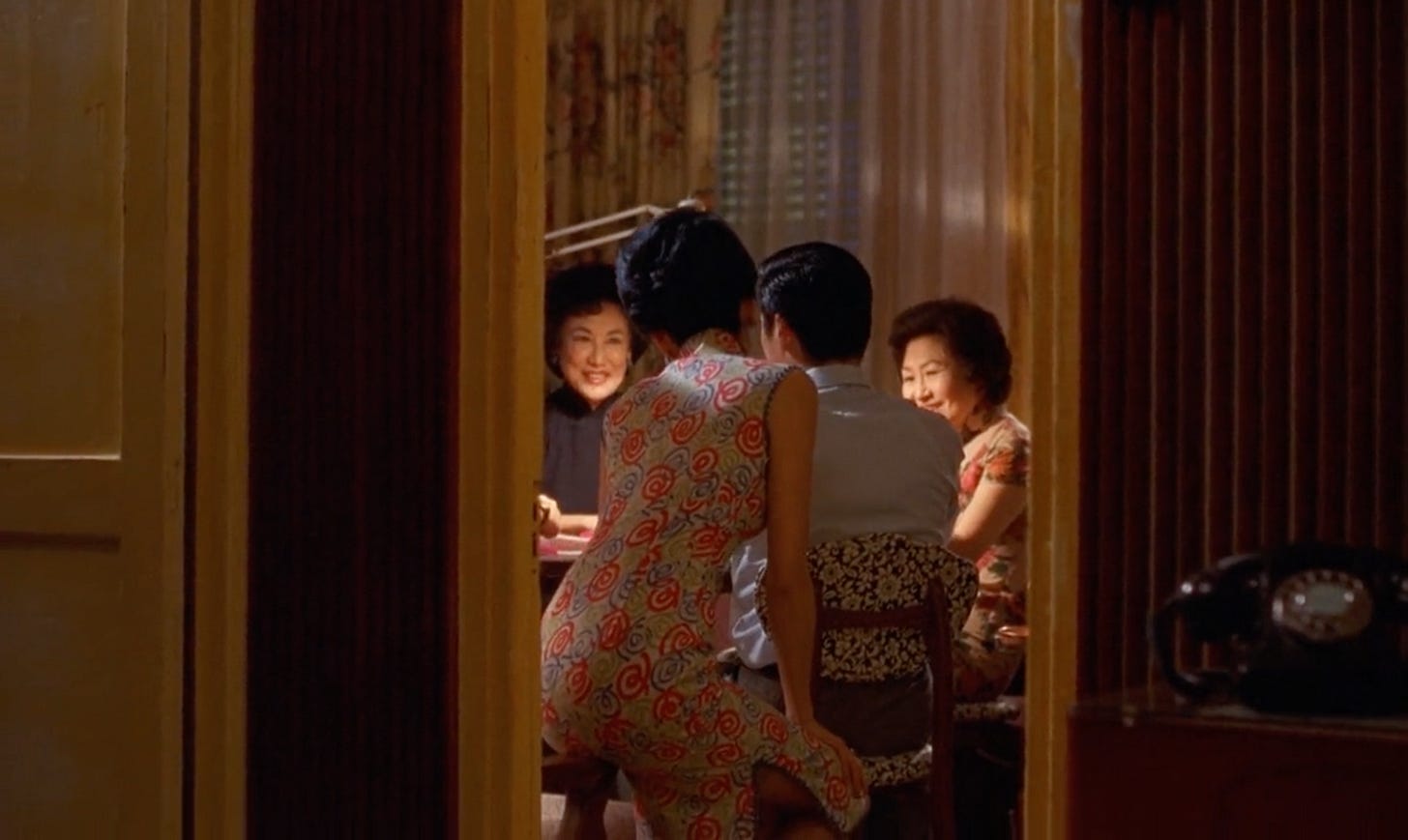
In the Mood for Love has two stories.The actual off-screen affair and the false on-screen one. We see the aftermath of the drama, not the drama itself. The reenactment, not the original. It’s an elegant twist on the melodrama. Nice. Neat. Simple. So let’s complicate it. Let’s say these two stories are in fact the one story repeated twice, with the same plot, same sets, same original cast. Let’s say Wong Kar-wai’s noir-ish melodrama is a time loop.
In case memory fails, or you don’t mind spoilers, the basic plot follows neighbours Chow Mo-wan and Su Li-zhen (or Mrs Chan) as they uncover an affair between their spouses. What begins with consoling conversations over coffee escalates, transforming into a psychosexual reenactment of the affair where the line between role and reality starts to blur. Is this how it began? they ask themselves, as they begin themselves.

Wong initially wanted all four roles of Mrs Chan and Chow, Mr Chow and Chan, to be played by Maggie Cheung and Tony Leung respectively.1 This didn’t translate to the final film, but not because two further leads were cast. The off-screen affair is off-screen; the cheating couple of Mrs Chow and Mr Chan don’t appear in the film. Claustrophobic sets and framing obscure, block and exclude the two from the camera’s eye. They are always around the corner, behind a vase, beyond our reach. Out of sight but never out of mind.

Never, because they are the true protagonists of the film. They may not be in it but they are in it. By recreating their affair, acting as they acted, saying what they said, doing where they did, Li-zhen and Mo-wan inhabit their counterparts’ lives so completely they obliterate themselves. They reenact the affair they suspect their spouses of and, as they do, the reenactment swallows their true identities and supplants them into their adopted roles. Mo-wan becomes Mr Chan, Li-zhen becomes Mrs Chow. This is an erasure of their own making. Under the domineering eyes of Li-zhen’s landlady and the Victorianism hangover that still haunts 1960s Hong Kong, every transgression has the reassuring caveat that this is not the first time it’s been done. They’re only doing what their partners did and even then they’re not going as far. They’re not crossing the line. The affair is happening again, but not really, not this time. This time will be different. They will be different.
An obsessive desire to correct the past pervades time loop narratives. And, if and when correction fails, you get to analyse what went wrong a hundred million times up close and personal. This is what the characters of In the Mood for Love are doing; retracing their spouses’ actions to make sense of the betrayal. Incapable of acceptance, unable to move on, they stall out and become their spouses instead, folding time over itself so that they might retread worn ground. Because we don’t see the original affair, we can’t know what started it. Since the (pseudo) affair we do see is instigated by the one we don’t we simply can’t get to the root cause. But take Li-zhen and Mo-wan as both themselves and their spouses and things begin to open up.
Gary Bettinson has pointed out that the narrative confuses the two couples on the corporeal level. In one scene, Li-zhen “confronts” her husband for cheating on her, only for a reverse shot to reveal that she was rehearsing the confrontation with Mo-wan. In another scene, where an out of focus woman showers and a man’s hand knocks on the door, we don’t know if this is Mr and Mrs Chan or Mr and Mrs Chow. It could easily be either.2 It seems Wong’s initial instinct to cast Cheung and Leung in double roles has been fulfilled after all. As the lines between characters fade, so too does time. One affair causes the other but really it’s just the one affair, recreating itself in a self-sustaining inescapable paradox of heartbreak.
There is nothing more romantic than being stuck in a time loop with someone.3 Here you are, the only two people in on the joke. You know this isn’t real, you know this is only a replay, you know what comes next and you know how this ends and under the weight of this shared secret you fall in love. But this is real. Time might loop but the things that happen within the loop stay with you and torture you. Heartbreak follows heartbreak and the only way to escape is to separate, but you won’t. So you reset and act like this is the beginning.
In the Mood for Love has two stories but no, it doesn’t. In the Mood for Love has one story and it’s looping again and again as love refuses to let go.
Rating: Doublisms / Loopel. Perhaps, perhaps, perhaps.
Brunette, Peter. Wong Kar-wai. Urbana-Champaign, 2005, p. 130.
See pp. 178 & 179 of Bettinson, Gary. “Happy Together? Generic Hybridity in 2046 and In the Mood for Love.” Puzzle Films: Complex Storytelling in Contemporary Cinema. Edited by Warren Buckland. Wiley-Blackwell, 2009, pp. 167-86.
See Palm Springs (2020).




